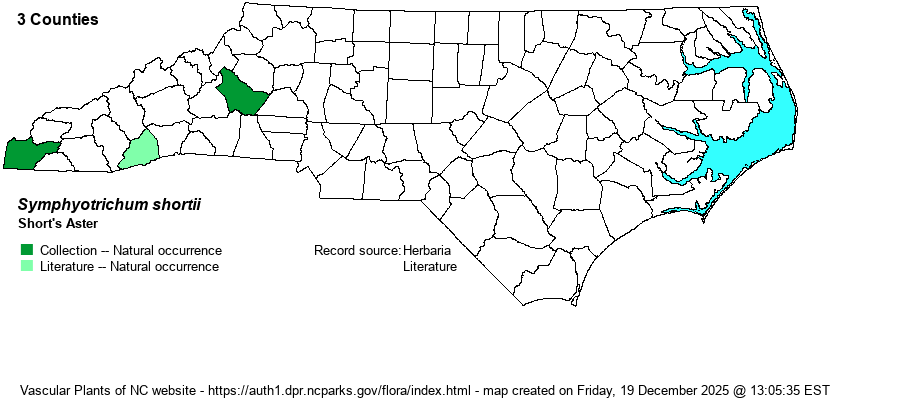| Author | (Lindley) G.L. Nesom | |
| Distribution | Mountains only. Discovered in NC in the past several decades; not known in NC when RAB (1968) was published. There are specimens from Burke, Cherokee, and Transylvania counties, plus unseen specimens reported from Polk County (not mapped). Most records have come from Cherokee County, by Ed Schwartzman, who located about 6 sites there, most or nearly all with sizable populations. The Burke County specimen (at BOON) is without label data and without image; it needs vetting. Sadly, there are no photos of the species reported on iNaturalist for NC.
PA to southern Ont. and MN, south to central GA, MS, and AR; disjunct to northwestern FL. In VA, known only from the extreme northern Piedmont; not in the Mountains there. | |
| Abundance | Rare but locally common in parts of Cherokee County; extremely rare elsewhere in the Mountains north to Burke County. Perhaps overlooked. The NCNHP has now (2024) given a State Rank of S1S2, instead of the former S2. It is listed as Significantly Rare. | |
| Habitat | Dry rocky slopes and open slope woodlands, probably limited to rather high pH soils, though soil affinities seem not to have been mentioned. | |
| Phenology | Flowering and fruiting late August-October. | |
| Identification | Short's Aster grows mostly 2-4 feet tall, with stem leaves that are slender-stalked and lance-shape, essentially entire, tapered to the tip, and with a slightly cordate or notched base of the blade. To many, the shape of the blade recalls leaves of Walking Fern (Asplenium rhizophyllum). S. undulatum has definitely widely-clasping leafstalks (vs. not). S. urophyllum has strongly toothed leaf margins (vs. not or weakly so); that species has a mostly glabrous upper stem, whereas S. shortii has a strongly pilose upper stem, and that species has mostly white rays as opposed to mostly light blue in S. shortii. Despite there being many other aster species in the Mountains with light blue rays and growing in upland forests and edges, the quite distinct lance-shaped and entire leaves are essentially unique in this region and make it clear the species was not overlooked as another species for so long, into the 21st Century. | |
| Taxonomic Comments | NOTE: The genus Aster was examined by G.L. Nesom (1994), who determined that it was composed of a number of discrete genera (a few of which were already split off by authors as Sericocarpus, Ionactis, etc.). The earliest available name for North American "Aster" is Symphyotrichum, a name regrettably long and hard to spell.
A synonym is Aster camptosorus.
| |
| Other Common Name(s) | None | |
| State Rank | S1S2 | |
| Global Rank | G5 | |
| State Status | SR-P | |
| US Status | | |
| USACE-agcp | | |
| USACE-emp | | |

